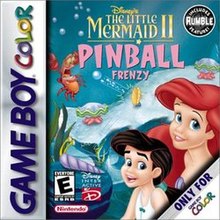
The Game Boy Advance (GBA) is a 32-bit handheld game console developed, manufactured and marketed by Nintendo as the successor to the Game Boy Color. It was released in Japan on March 21, 2001, in North America on June 11, 2001, in the PAL region on June 22, 2001, and in mainland China as iQue Game Boy Advance on June 8, 2004. The GBA is part of the sixth generation of video game consoles. The original model does not have an illuminated screen; Nintendo addressed that with the release of a redesigned model with a frontlit screen, the Game Boy Advance SP, in 2003. A newer revision of the redesign was released in 2005, with a backlit screen. Around the same time, the final redesign, the Game Boy Micro, was released in September 2005.
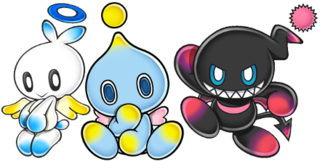
Chao are fictional life-forms in the Sonic the Hedgehog video game series published by Sega. They are small, childlike creatures that go through a complex life cycle and exist in several visual forms depending on how they are raised. Developer Sonic Team incorporated Chao into the games to encourage players to explore levels and support the good–evil dichotomy of Sonic Adventure 2.

The Game Boy Printer, known as the Pocket Printer in Japan, is a thermal printer accessory released by Nintendo in 1998 which ceased production in early 2003. The Game Boy Printer is compatible with all the Game Boy systems except the Game Boy Micro and is designed to be used in conjunction with the Game Boy Camera. It also prints images from compatible late-generation Game Boy and Game Boy Color games. It runs on six AA batteries and uses a proprietary 38mm wide thermal paper with adhesive backing, originally sold in white, red, yellow and blue colors. In Japan, a bright yellow Pokémon version of the Game Boy Printer was released, featuring a feed button in the style of a Poké Ball.

Eevee is a Pokémon species in Nintendo and Game Freak's Pokémon franchise. Created by Motofumi Fujiwara, it first appeared in the video games Pokémon Red and Blue. It has later appeared in various merchandise, spinoff titles, as well as animated and printed adaptations of the franchise. It is also the game mascot and starter Pokémon for Pokémon: Let's Go, Eevee!
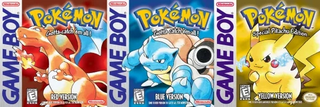
Pokémon Red Version and Pokémon Blue Version are 1996 role-playing video games developed by Game Freak and published by Nintendo for the Game Boy. They are the first installments of the Pokémon video game series. They were first released in Japan in 1996 as Pocket Monsters: Red and Pocket Monsters: Green, with the special edition Pocket Monsters: Blue being released in Japan later that same year. The games were later released as Pokémon Red and Pokémon Blue in North America and Australia in 1998 and Europe in 1999. Pokémon Red and Pokémon Blue combined Red/Green/Blue for release outside of Japan.
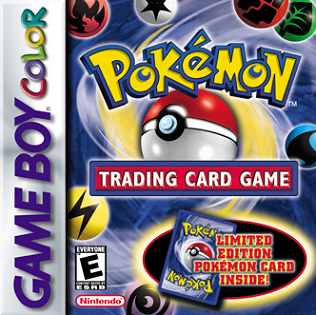
Pokémon Trading Card Game is a video game adaptation of the original tabletop trading card game of the same name, which in turn was based on the Pokémon role-playing video game series. Developed by Hudson Soft and Creatures, and published by Nintendo, it was initially released in Japan on December 18, 1998, with an English version appearing in Australia on April 7, 2000, North America on April 10, 2000, and in Europe the following December. The title features digital versions of cards from the first three sets of the trading card game originally released in English by Wizards of the Coast between 1998 and 1999, as well as exclusive cards not available outside of the game. The game was released as part of the Nintendo Switch Online service in 2023.

Magikarp, known in Japan as Koiking, is a Pokémon species in Nintendo and Game Freak's Pokémon franchise. Created by Ken Sugimori, Magikarp first appeared in the video games Pokémon Red and Blue and subsequent sequels. They have later appeared in various merchandise, spinoff entries, and animated and printed adaptations of the franchise. Known as the Fish Pokémon, Magikarp is found in many bodies of water, especially lakes, rivers, and ponds. Magikarp received mixed responses from critics, with some criticism directed towards it for being useless or pointless.

Pokémon Gold Version and Pokémon Silver Version are 1999 role-playing video games developed by Game Freak and published by Nintendo for the Game Boy Color. They are the first installments in the second generation of the Pokémon video game series. They were released in Japan in 1999, Australia and North America in 2000, and Europe in 2001. Pokémon Crystal, a third version, was released a year later in each region. In 2009, on the 10th anniversary of Gold and Silver, remakes titled Pokémon HeartGold and SoulSilver were released for the Nintendo DS.

The Pokémon Mini is a handheld game console that was designed and manufactured by Nintendo and themed around the Pokémon media franchise. It is the smallest game system with interchangeable cartridges ever produced by Nintendo, weighing just under two and a half ounces. It was first released in North America on November 16, 2001, then in Japan on December 14, 2001, and in Europe on March 15, 2002. The systems were released in three colors: Wooper Blue, Chikorita Green, and Smoochum Purple.

Kirby's Pinball Land is a 1993 pinball video game developed by HAL Laboratory and published by Nintendo for the Game Boy. It was HAL Laboratory's third pinball video game after the MSX and NES title Rollerball and the Game Boy title Revenge of the 'Gator. It was also the first spin-off and second Game Boy title in the Kirby series, as well as the second pinball video game Nintendo published after the NES title Pinball. The game was rereleased on the Nintendo 3DS Virtual Console service in July 2012.
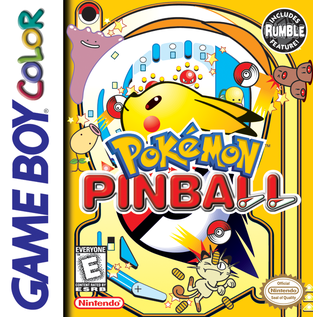
Pokémon Pinball is a pinball-based Pokémon spin-off video game for the Game Boy Color. It was released in Japan on April 14, 1999, and in North America on June 28, 1999. In it, the ball is a Poké Ball, and most of the objects on the table are Pokémon-related.

Pokémon Pinball: Ruby & Sapphire is a 2003 pinball game developed by Jupiter, published by The Pokémon Company and distributed by Nintendo for the Game Boy Advance handheld game console. It was first revealed at E3 2003. The North American release was done to coincide with the fifth anniversary of the North American release of Pokémon Red and Blue. It is based on Pokémon Ruby and Sapphire, and is a sequel to Pokémon Pinball for the Game Boy Color. In some ways, it plays like a traditional pinball game, where the objective is to get a high score by keeping the ball in play as long as possible and hitting bumpers. In keeping with the theme of Pokémon, it features Pokémon collection, where while the players play pinball, they must also capture the eponymous creatures.
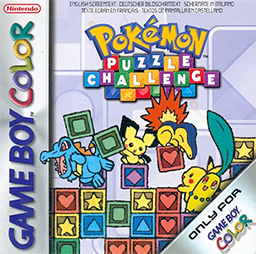
Pokémon Puzzle Challenge is a video game for the Game Boy Color. It is based on Panel de Pon, only with characters from the Pokémon franchise. The characters in Pokémon Puzzle Challenge are based on those in the Gold and Silver games, while those in Pokémon Puzzle League—its Nintendo 64 equivalent—were based more on the anime characters. However, the game is also focused around beating the Johto leaders in a puzzle challenge in Johto region. The game play mode is divided into 1 Player, 2 Player, and Training. The game was later released on the Nintendo eShop on November 6, 2014.
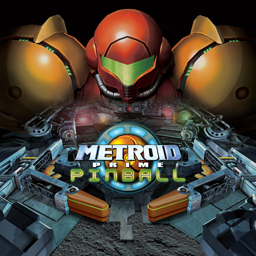
Metroid Prime Pinball is a pinball video game themed after the Metroid series. The game uses the graphical style and various story elements from Metroid Prime. It was developed by Fuse Games and published by Nintendo for the Nintendo DS in North America and Australia in 2005, in Japan in 2006, and in Europe in 2007. Metroid Prime Pinball uses the basic mechanics of pinball, along with typical pinball items. New mechanics are introduced, such as wall jumping and the ability to fire weapons. The Nintendo DS's touchscreen can be nudged with a finger to alter the pinball's trajectory while in motion.

The Pinball of the Dead is a pinball video game developed by Sega's Wow Entertainment division and published by Sega in Japan and THQ in North America. It was released for the Game Boy Advance on June 19 and July 4, 2002, in North America and Japan, respectively. Based on Sega's The House of the Dead series of light gun games, particularly The House of the Dead and The House of the Dead 2, the game contains three tables and includes a "Challenge" mode. Full-motion video sequences and audio samples from previous games were also added. The game was first announced during the 2001 Nintendo Space World. Composer Hitoshi Sakimoto was involved with making the game's music.
Left Field Productions, Inc. was an American independent video game development studio located in Ventura, California. Founded in 1994 by industry veterans John Brandwood, Jeff Godfrey and Mike Lamb, Left Field is probably best known for their time spent as a Nintendo third-party developer, during which they designed the critically acclaimed Nintendo 64 game Excitebike 64.
This is a list of video game accessories that have been released for the Game Boy handheld console and its successors. Accessories add functionality that the console would otherwise not have.

The Little Mermaid is a Disney media franchise. The success of the 1989 American animated feature film The Little Mermaid led to a direct-to-video sequel, a prequel film, a spin-off television series, a musical, several video games, theme park attractions, and other merchandise. A live action remake of the film is in development for release in 2023. The Little Mermaid paved the way for what would become the Disney Renaissance, with the original film becoming the first film of that era.

Pichu is a Pokémon species in Nintendo and Game Freak's Pokémon franchise. Created by Ken Sugimori, Pichu first appeared in the video games Pokémon Gold and Silver and subsequent sequels, later appearing in various merchandise, spinoff titles and animated and printed adaptations of the franchise. There have been multiple voice actors for Pichu. The two Pichu Brothers characters were voiced by Yumi Tōma and Satomi Kōrogi, while a spiky-eared Pichu from the film Arceus and the Jewel of Life was voiced by Shōko Nakagawa and Kayzie Rogers.
